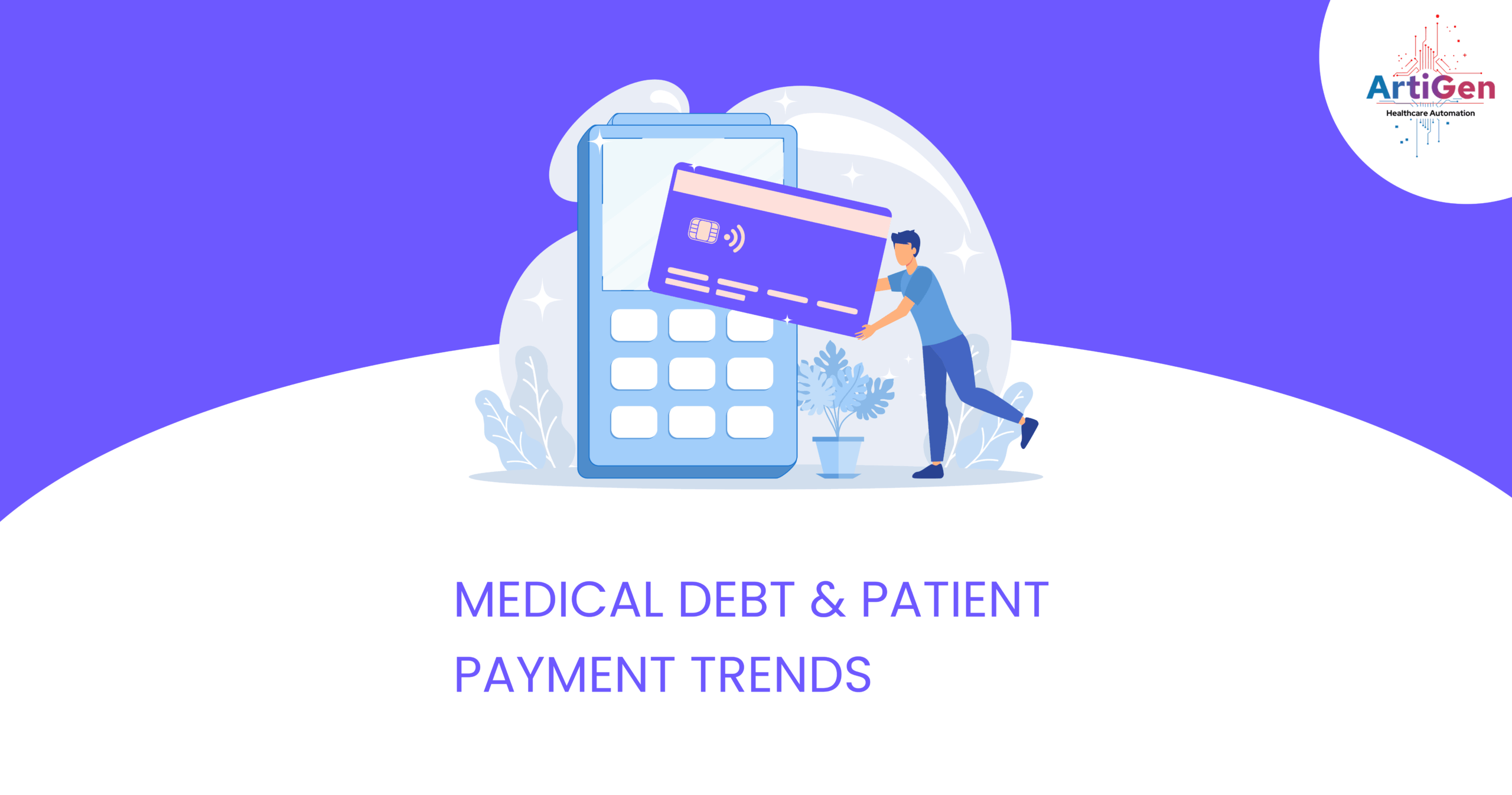

MEDICAL DEBT & PATIENT PAYMENT TRENDS: A SHIFTING LANDSCAPE
Healthcare has always been a paradox. It represents humanity’s most noble pursuit—healing the sick, saving lives—yet it also brings some of the most difficult financial decisions a person may ever face. One hospital visit, a sudden diagnosis, or an unexpected emergency can rewrite the financial future of an entire household. Medical debt is not a niche issue; it is a global reality, and its effects ripple far beyond hospital walls. Families struggling with healthcare costs often face the added pressure of ongoing medical expenses, while lack of price transparency only complicates the situation. The rise of surprise billing in many regions adds to the burden, just as healthcare inflation keeps pushing financial limits. For patients with chronic conditions care, the cycle is ongoing, making flexible patient payment trends essential. Meanwhile, global healthcare systems face the same challenges, whether dealing with credit reporting changes, implementing debt relief initiatives, or addressing medical billing challenges such as third-party financing and rising deductibles.
Over the last decade, the conversation about medical debt has grown louder, more urgent, and more complex. Governments are introducing reforms, hospitals are experimenting with flexible payment plans, new patient-friendly billing models, and technology is reshaping how financial transactions in healthcare are managed. But perhaps the most important shift is this: the industry is beginning to recognize that financial health and physical health are deeply intertwined. Healthcare costs, especially rising deductibles, force households to choose between treatment and essentials, and unresolved medical expenses can destroy financial stability. The lack of price transparency combined with surprise billing continues to create new medical billing challenges, despite reforms and debt relief initiatives. In global healthcare systems, the effects of healthcare inflation mean even basic chronic conditions care becomes difficult without third-party financing support.
This article explores the evolving story of medical debt and patient payment trends—why the crisis persists, how policies and providers are adapting, and what the future might hold.
WHY MEDICAL DEBT PERSISTS
Despite reforms and innovations, the reasons medical debt continues to climb are rooted in both economics and structure. Healthcare costs rise yearly, while rising deductibles leave patients vulnerable. Ongoing medical expenses make survival difficult for families without savings, and price transparency is still far from reality. At the same time, surprise billing shocks patients with unexpected invoices, while healthcare inflation amplifies every cost. Families managing chronic conditions care face bills that repeat monthly, making flexible payment plans necessary. Across global healthcare systems, policymakers are working on credit reporting changes, testing debt relief initiatives, but still facing medical billing challenges. Even third-party financing often brings risk, and rising deductibles force patients into long-term debt.
- Rising Out-of-Pocket Costs
Insurance coverage may look secure on paper, but high deductibles and co-pays leave patients responsible for significant amounts. For families already stretched thin, a $3,000 deductible feels more like a mountain than a minor hurdle. These rising deductibles become a leading factor in medical debt, creating unbearable healthcare costs. The weight of ongoing medical expenses without flexible payment plans magnifies the crisis, especially when combined with healthcare inflation. - Fragmented Billing Systems
A single hospital stay may generate separate bills from the facility, surgeons, anesthesiologists, labs, and imaging providers. Even the most financially savvy patient can become confused, let alone someone unfamiliar with medical jargon. Adopting streamlined patient payment trends can reduce confusion and improve payment compliance. - Surprise billing
although legislation in several countries aims to reduce “surprise” out-of-network charges, gaps remain. Patients who think they’re covered often discover unexpected invoices weeks later. This worsens medical debt, adds to healthcare costs, and highlights the need for debt relief initiatives and credit reporting changes. Without flexible payment plans, patients in global healthcare systems are often left vulnerable. - Chronic Conditions and Long-Term Care
Unlike a one-time surgery, conditions such as cancer, heart disease, or diabetes create ongoing financial obligations. These chronic conditions care needs require monthly medical expenses, which quickly pile up into medical debt. Families seek flexible patient payment trends, but rising deductibles and healthcare inflation make affordability harder. The lack of price transparency adds to medical billing challenges, forcing many into third-party financing. - Economic Pressures
Global inflation, stagnant wages, and rising living costs amplify the weight of medical expenses. In many households, medical expenses compete with rent and groceries. This fuels medical debt across global healthcare systems, where healthcare inflation worsens the crisis. Without debt relief initiatives, credit reporting changes, or flexible payment plans, families remain trapped in a cycle of rising deductibles, surprise billing, and medical billing challenges. These forces converge to keep medical debt firmly in place as one of the most stubborn financial challenges of modern life.
THE POLICY ENVIRONMENT: RELIEF EFFORTS AND CHALLENGES
Medical debt has become a policy talking point worldwide. Governments address healthcare costs through reforms, while organizations push for debt relief initiatives and credit reporting changes. In the U.S., nonprofits purchase and forgive outstanding medical expenses. In global healthcare systems, price transparency laws are gaining momentum to reduce medical billing challenges.
- Debt Relief Initiatives: In the U.S., nonprofits like RIP Medical Debt have pioneered programs that purchase outstanding debt at discounted rates and forgive it entirely. For many families, receiving a letter saying, “Your debt has been erased” is nothing short of life-changing.
- Credit Reporting Changes: Recognizing the unique burden of medical debt, credit bureaus have begun softening how unpaid medical bills affect credit scores. This small but significant reform helps families avoid long-term damage to their financial profiles.
- Price Transparency Laws: Regulators are requiring hospitals to publish clear costs for common procedures. Transparency empowers patients to make informed choices, though compliance and clarity remain inconsistent.
- Global Approaches:
- In India, government insurance schemes such as Ayushman Bharat are expanding coverage, though private expenses still weigh heavily.
- In Europe, robust social health insurance systems reduce catastrophic debt but may leave patients vulnerable in areas like dental care or prescriptions.
- In Australia and Canada, hybrid models create partial protection but also ongoing debates about equity.
The overarching theme is that no system is immune. Even where healthcare is considered a right, the fine print of coverage, waiting lists, and uncovered medical services still create stress for families.
THE HUMAN IMPACT: BEYOND THE NUMBERS
While reports often focus on statistics—billions in unpaid medical debt, percentages of households affected—the deeper truth is that medical debt changes lives in subtle but profound ways.
- Families delay follow-up care, risking worse health outcomes and increased medical expenses.
- Individuals ration prescriptions, stretching doses because they can’t afford refills, increasing healthcare costs and contributing to medical debt.
- Parents sacrifice children’s education funds or retirement savings to stay afloat, often due to rising healthcare inflation and chronic conditions care costs.
- Stress from financial strain worsens mental health, creating a cycle where both body and mind suffer, compounded by surprise billing and lack of price transparency.
In this sense, medical debt is not only a financial issue but a health issue in itself. The weight of unpaid bills can cause anxiety, depression, and avoidance of care—outcomes that contradict the very purpose of healthcare while highlighting the importance of flexible payment plans, debt relief initiatives, and credit reporting changes.
PAYMENT TRENDS: WHAT PATIENTS NEED AND EXPECT
Healthcare billing is evolving in response to these pressures. Several trends illustrate the shift toward patient-centric financial models:
- Flexible Payment Plans
Hospitals increasingly offer flexible payment plans, including interest-free installment options. These plans help manage medical debt, reduce healthcare costs, and make large medical expenses more manageable. They are especially helpful for patients managing chronic conditions care and adopting effective patient payment trends. - Digital Billing Tools
From online portals to mobile apps, patients now expect the convenience of managing bills the same way they handle banking or shopping—through clear interfaces, reminders, and real-time updates. These tools improve price transparency, reduce surprise billing, and help control medical debt and healthcare costs. - Upfront Cost Estimates
Advances in analytics allow providers to estimate healthcare costs before procedures. While not always exact, these projections reduce medical debt, help plan for medical expenses, and improve price transparency and chronic conditions care. - Third-Party Financing
Financial technology companies are entering the healthcare space, offering structured loans or deferred payment plans (third-party financing). These partnerships help manage medical expenses, reduce medical debt, and make healthcare costs more predictable. - Employer Involvement
some employers are stepping in with medical debt assistance programs, health savings accounts, or flexible payment plans. As healthcare costs rise, these workplace benefits become a critical line of defense against medical debt and help with chronic conditions care while promoting price transparency and reducing surprise billing and supporting patient payment trends.






